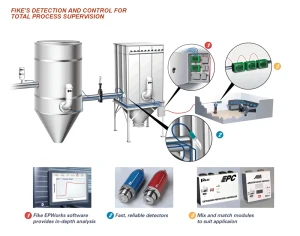Fike has the most advanced control systems available in today’s explosion protection market.
Fike has the most advanced control systems available in today’s explosion protection market. Fike’s Detection and Control Systems are pre-configured to recognize danger signs and make important decisions about when to activate explosion isolation and/or explosion suppression systems, effectively preventing an explosion from damaging your equipment and facility. Your employees don’t have to search your facility for signs of a problem. Our control systems not only tell you where the trouble is, they tell you what the problem is and when it happened. Fike explosion protection puts you in complete control.
Fike’s exclusive bus technology communicates system status, activates system protection, and allows for remote access. Fike’s exclusive EPWorks™ software reports system status, pressure readings, and pre/post system activation history in easily understandable graphs, giving you more information at your fingertips.
Modular design
Though sophisticated, its modular design, small size, global compatibility and pre-configured set-ups make Fike’s control systems both flexible and easy-to-use. Made up of five basic modules, our systems are easy to install, fully compatible and easily programmable. Choose just one or a combination of the modules to create precisely the explosion protection system that’s right for your application.
- Annunciator Module (AM): command/communication central with complete history retrieval function
- Relay Card (RC8): relays for process equipment interface, allowing the system to discriminate between critical and non-critical trouble conditions
- Power Supply Unit (PSU): uninterruptible power supply for added safety and complete reliability
- Ceramic Detector: detection that is virtually invulnerable to damage and false activation
- Explosion Protection Controller (EPC): offers multiple hazard protection, and activation pressure and status/event history
How Explosion Venting Works
Explosion venting, one of the most common and effective forms of explosion protection, offers overpressure protection from potential industrial explosion hazards by providing a planned pathway for the expanding gases to escape.




